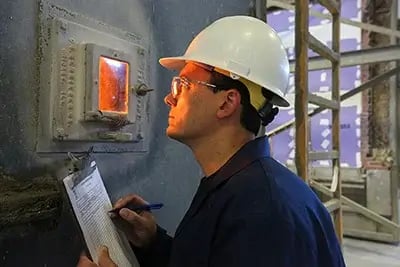How do we determine that a wall assembly, partition, roof, or floor that you manufacture will be safe when exposed to fire? We rely on the ASTM E119 testing method.
This comprehensive test allows us to evaluate the duration for which certain building elements can contain a fire, retain their structural integrity, or exhibit both properties during a predetermined test exposure.
What Is an ASTM E119 Fire Test?
The ASTM E119 fire test is a standardized test method used to evaluate the fire resistance of building components and assemblies. It is conducted in accordance with the ASTM E119 or UL 263 (Underwriters Laboratories) standard.
One of many types of fire testing standards, this test measures the ability of a construction material — such as a wall, partition, roof, or floor — to withstand exposure to fire for a specified period of time.
The results of an ASTM E119 fire test provide valuable information for building code officials, architects, engineers, and construction professionals.
The test helps ensure that building components and assemblies meet the required fire safety standards and provide a level of protection to occupants and property in the event of a fire. It aids in the design and construction of fire-resistant buildings, allowing for effective fire prevention, containment, and evacuation strategies.
How We Conduct an ASTM E119 Fire Test
To conduct this test, we uniformly expose numerous building elements to fire, with temperatures and fire conditions that simulate a real-world fire scenario. The test evaluates two primary performance criteria, including:
- Fire resistance – containment of fire and heat
- Structural integrity – load-carrying ability during test exposure
The duration of the fire exposure varies depending on the fire rating being tested, typically ranging from 45 minutes to several hours.

We monitor the testing material for factors such as flame penetration, temperature rise on the unexposed side, structural stability, and the integrity of fire barriers. We also evaluate the period of resistance before the first critical point of failure is observed.
Understanding the Pass/Fail Criteria
In the ASTM E119 fire test, the evaluation of a building component's fire resistance is determined based on pass/fail criteria. These criteria play a crucial role in assessing the performance of the tested material and ensuring its compliance with fire safety standards.
The following critical timed events are recorded during the ASTM E119 test. Pass/fail (endurance time of the assembly) is when the first of these events occurs:
- The temperature rises to 250 degrees F above the ambient temperature on the average of all unexposed surface thermocouple locations.
- The temperature rises to 325 degrees F above the ambient temperature on any single unexposed surface thermocouple location.
- For assemblies where structural steel members are utilized, the maximum temperature on a structural steel member exceeds 1,100 degrees F.
- Any flaming is observed on the unexposed surface of the test specimen.
- Smoke and/or gas emissions are hot enough to ignite cotton waste material applied on the specimen's unexposed surface.
- Failure to sustain the applied load during exposure of load-bearing assemblies. In many cases, the ASTM E119 test requires an additional evaluation of the assembly where it is subjected to a hose stream test to establish a fire-resistance rating.
Components that successfully meet the criteria demonstrate their ability to withstand fire exposure for the specified duration without compromising their integrity or contributing to the fire's spread.
It's important to note that the specific pass/fail criteria may vary depending on the fire rating being tested and the applicable building codes and regulations.
Importance of Compliance With Pass/Fail Criteria
Building code officials, architects, and engineers rely on the results of an ASTM E119 fire test to verify compliance with fire safety standards and make informed decisions regarding the design and construction of fire-resistant buildings.
Here are some key reasons why compliance with these criteria is crucial.
Life Safety
Compliance ensures that buildings are designed and constructed to effectively contain and control fires, allowing occupants sufficient time for evacuation and reducing the risk of injury or loss of life.
Property Protection
Fire-resistant construction elements and assemblies play a crucial role in preventing fire from spreading to other areas of the building, limiting the extent of the fire's impact, and protecting valuable assets.
Code and Regulatory Compliance
Failure to comply with the prescribed criteria can result in code violations, potential legal consequences, and difficulties in obtaining occupancy permits.
Insurance and Liability Considerations
Insurance providers often assess the fire resistance measures implemented in a building when determining coverage options and premiums. Non-compliance with the prescribed criteria may result in increased insurance costs or even denial of coverage.
Additionally, failure to meet fire safety standards can expose building owners, developers, and contractors to potential liability in case of fire-related incidents.
Ensuring Building Safety With ASTM E119
By understanding the pass/fail criteria of an ASTM E119 fire test, you can ensure that your building components and assemblies meet the required standards and contribute to a safer built environment.
NGC Testing Services has been a trusted provider of comprehensive fire testing for over 55 years. Our fully-accredited facility is equipped to handle ASTM E119 testing projects of any scale. We’re dedicated to delivering accurate and reliable testing results while making the process as easy as possible for you.
For more details about the ASTM E119, including information about what this test standard does not provide, contact our team of experts.
This post was originally published in September 2021 by Bob Menchetti and was updated and republished in July 2023.
Search blog articles
Browse by topic
Subscribe for updates
LEARN MORE
Related Blog Articles
GET IN TOUCH
Contact Us
NGC Testing Services features one of North America's most comprehensive and unique fully accredited testing facilities. Contact us today to visit our 50,000-plus-square-foot facility located in Buffalo, New York.


